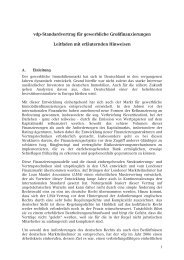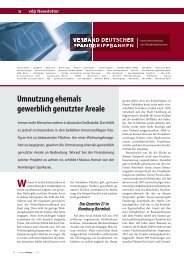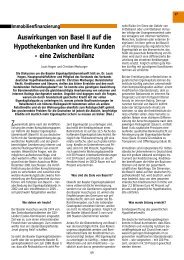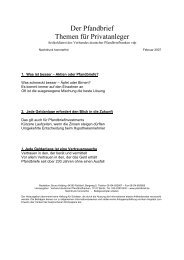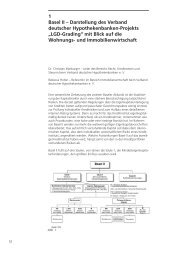The Pfandbrief 2011 | 2012
The Pfandbrief 2011 | 2012
The Pfandbrief 2011 | 2012
You also want an ePaper? Increase the reach of your titles
YUMPU automatically turns print PDFs into web optimized ePapers that Google loves.
Quo vadis? <strong>The</strong> regulatory treatment of <strong>Pfandbrief</strong>e under Solvency II<br />
<strong>The</strong> calculation of capital requirements under Solvency II<br />
38<br />
Under the regulations, the Solvency Capital Requirement (SCR) is the amount of capital that<br />
undertakings will be required to hold in order to carry out regulated operations. <strong>The</strong> Minimum<br />
Capital Requirement (MCR) defines the lowest level at which a business may maintain operations.<br />
If capital falls below this level, the undertaking may not be allowed to take on new business.<br />
If necessary, an undertaking’s authorisation to operate may also be revoked. A ladder<br />
of supervisory intervention exists between the SCR and MCR which establishes supervisory<br />
powers on the basis of an insurer’s solvency situation. <strong>The</strong> ladder of supervisory intervention<br />
is intended to ensure that insurers receive equal treatment. This catalogue of measures also<br />
makes it possible for insurers to predict what action will be taken by the supervisory authorities.<br />
<strong>The</strong> further an insurer falls below the SCR, the more far-reaching the supervisory authority’s<br />
powers become.<br />
<strong>The</strong> regulatory capital requirements under the first pillar are calculated using a riskoriented<br />
approach. Specifically, this means that insurers must include in the calculation all<br />
relevant risks to which they are exposed by their operations. <strong>The</strong> assumption for all types of<br />
risk is that the assumed loss will not exceed a probability of 99.5%. <strong>The</strong> risks calculated are<br />
then combined using a correlation matrix. Since it is correctly assumed that there is not a<br />
positive linear relationship between the various risks, the correlation coefficients are lower<br />
than 100%. In other words, the risks will not materialise in full at the same time.<br />
In addition to the technical risks in the life, health and non-life segments, insurers must<br />
also include the market and counterparty risks in the calculation. Market risk consists, in turn,<br />
of six sub-risks: interest rate risk, equity risk, property risk, spread risk, foreign exchange risk<br />
and concentration risk 1) . An insurer’s assets must be allocated to the corresponding sub-risks.<br />
<strong>The</strong> interest rate risk, spread risk and concentration risk are of particular significance for<br />
<strong>Pfandbrief</strong>e and covered bonds.<br />
Interest rate risk<br />
<strong>The</strong> interest rate risk reflects the risk that the risk-free market interest rate will change and<br />
thus lead to a decrease or an increase in the market values of fixed-income assets on both<br />
sides of the balance sheet. <strong>The</strong> greater the difference in duration between the interest-bearing<br />
assets on the asset side and the liabilities on the liabilities side, the greater the insurer’s interest<br />
rate risk. For this reason there is no fixed capital requirement for <strong>Pfandbrief</strong>e or other<br />
fixed-income securities resulting from the interest rate risk. If the duration on the asset and<br />
liabilities sides is exactly the same, the capital requirement resulting from the interest rate risk<br />
may even in principal be eliminated. It is particularly important for life insurers to close this<br />
duration gap as they typically have relatively long-term liabilities in their portfolios.<br />
1)<br />
In QIS5, an illiquidity premium risk also had to be included in the calculation. This risk related exclusively to an insurer’s<br />
liabilities. At the time of going to press, it was not certain whether the illiquidity premium risk would actually be established<br />
as part of the standard model.




